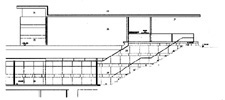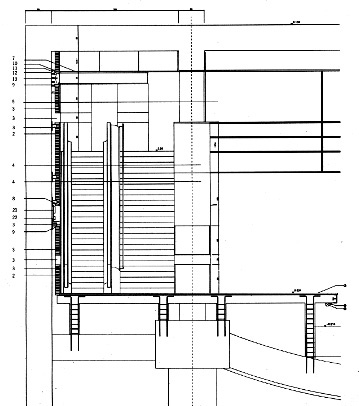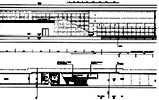| El proyecto de las
estaciones se plantea, partiendo de un trazado preexistente, como una intervención de
mejora y adecuación del diseño interior de los diferentes espacios, valorandose como
elemento público totalmente alejado del concepto de monumentalidad y retórica, pero no
de dignidad. Para ello es fundamental
la elección de materiales en cuanto a su durabilidad, la racionalidad constructiva que
resuelve el problema de la complejidad de las instalaciones del metro y la economía, en
relación a la utilización de materiales de la zona. Se aprovecha la manufactura de los
pequeños talleres locales, que aportan soluciones tradicionales, al mismo tiempo que
sistemas estandarizados.
Basado en la idea lineal de velocidad con
inexistencia de ritmo para evitar la sensación de escala que produciría una sala de 100
metros de largo por 15 de ancho y 9 de gálibo, se disponen en los andenes los materiales
en tres bandas diferenciadas, un zócalo de granito que se prolonga como pavimento e
incluso como material del mobiliario, una banda con perfilería de acero inoxidable y
vidrios laminares donde se incorporan los sistemas de iluminación, rejillas de aire,
señalización y cableado; una tercera con placas de mármol de Almería de distintos
colores que permiten la identificación de cada una de las paradas, y la cuarta y última
con estucos blancos donde se colocan los murales de artistas valencianos.
Todo este sistema se separa de los muros pantallas
con una estructrua metálica apoyada y en voladizo sobre el muro pantalla para permitir la
ventilación y el paso de instalaciones con suficiente holgura.
Los vestibulos se proyectan como grandes bandejas
que vuelcan sobre los andenes y es en ellos donde aparece la iluminación en el falso
techo de acero inoxidable y donde se ubican cajas de control como elementos ligeros de
vidrio y acero inoxidable. |
The project for
these stations is approached from the initial situation of an existing layout, as an
improvement and fitting of the interior design of the spaces in question. Their
enhancement as public areas is far removed from any notion of monumentality and rhetoric
without renouncing dignity. The choice of
materials from the point of view of durability, rational construction solutions in
response to the complexity of the Metro installations and economy are thus of the utmost
importance. Related to the latter is the use of local materials, taking advantage of the
products of small local manufacturers which standardised systems.
Based on the linear idea of speed with an inexistent rhythm
in order to avoid the sensation of scale that a hall 100 metres long by 15 metres wide and
9 metres clearance would produce, the materials are arranged in three differentiated bands
on the platforms: a granite skirting extends outwards to provide the paving material and
even the material employed for the furniture, a band of stainless steel profiles and
laminated glass holds the lighting systems, air grilles, signals and wiring, while a third
band, of Almeria marble slabs in different colours, identifies each of the stops. The
fourth and last band, of white stucco, holds murals by Valencian artists.
All this system is separated from the core walls by a metal
structure, supported by and projecting out from the core wall, wich provides ample space
for ventilation and the passage of the service installations.
The halls are designed as great trays overlooking the
platforms. These are where the lighting makes its appearance in the stainsless steel
ceiling and the control boxes, in the form of light stainless steel and glass units, are
located. |
 

|









